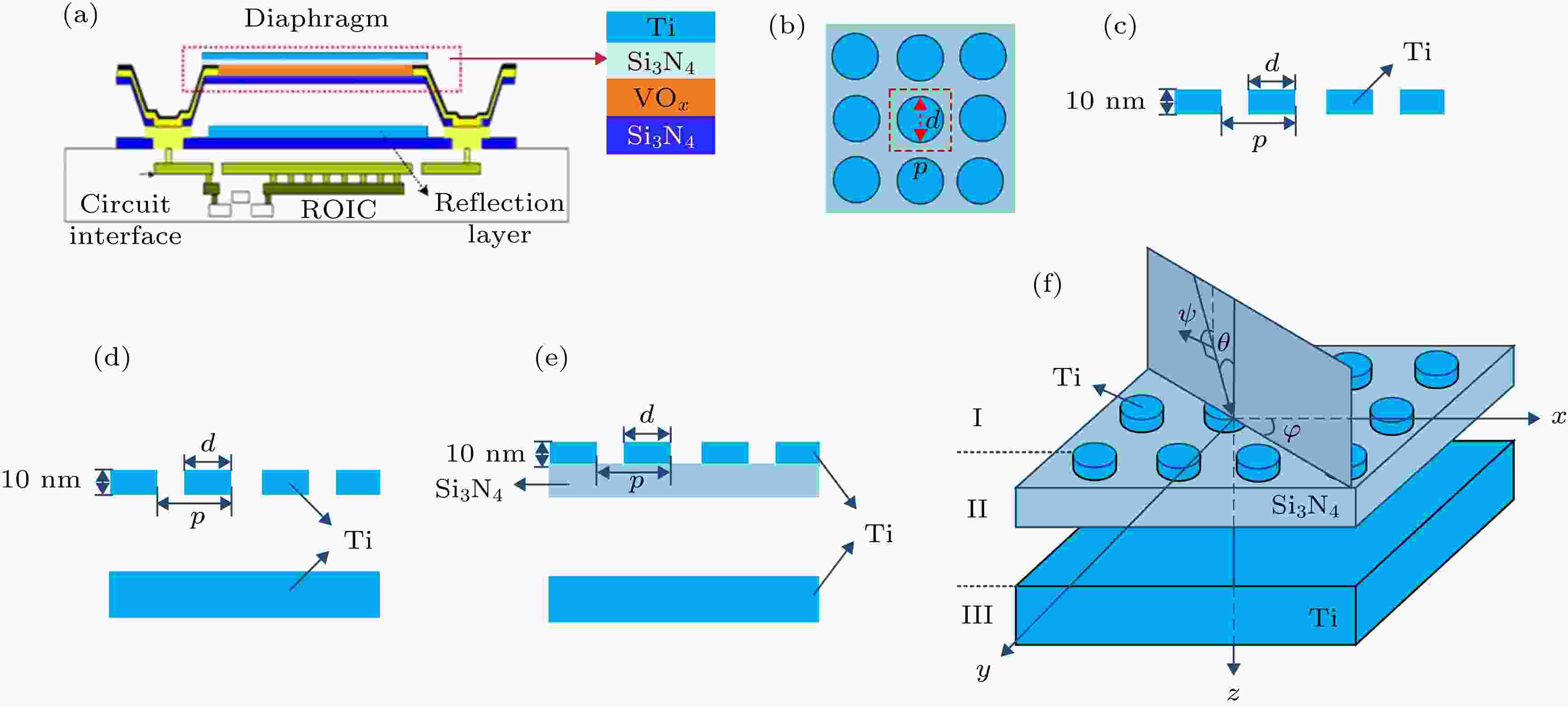全文HTML
--> --> -->由于太赫兹波处于与红外光相邻近的波段, 而微测辐射热计型红外探测器技术已非常成熟. 红外微测辐射热计在太赫兹辐射源的照射下可以用于太赫兹波段的探测与成像[11-13], 但传统的红外微测辐射热计微桥结构无法对波长较长的太赫兹波进行谐振吸收, 导致器件对目标辐射的吸收极低(< 4%), 难以提供较高的响应与灵敏度[14]. 因此, 需要增加太赫兹波吸收层. 金属薄膜由于电阻损耗可以吸收太赫兹波, 且具有低热容、高热导及与微桥结构的制备工艺兼容等优点, 成为太赫兹微测辐射热计中吸收材料的首选[15-17], 表面修饰可进一步提高金属薄膜的有效吸收面积[18], 但金属薄膜吸收太赫兹波的理论上限仅50%[19]. 将天线、超材料等吸波结构集成到微桥结构中可有效提高太赫兹微测辐射热计的吸收率. 法国CEA-Leti实验室制备出11 μm高的介质谐振腔结构, 采用多层天线耦合的方法, 显著提高了太赫兹波吸收率和探测灵敏度[20,21]. 但是, 高谐振腔微桥结构的制备与电学连通实现难度较大, 多层天线结构复杂, 集成性与工艺兼容性有待改善.
在光学波段, 表面等离子体激元(surface plasmon polaritons, SPPs)是金属与介质交界面处自由电子气的集体共振, 能够将电磁波约束在纳米级别的尺寸结构中, 具有克服衍射极限和在亚波长尺寸内操纵光束的能力[22,23]. 而金属的等离子体频率一般位于可见光和紫外波段, 在微波和太赫兹波段类似于理想导体, 电磁波渗透能力很弱, 所以表面电子和电磁波的相互耦合作用非常微弱, 使得SPPs表面电磁模式变得非常微弱[24]. 2004年, Pendry等[25]提出了伪表面等离子体(spoof surface plasmon polaritons, sSPPs)理论, 在金属表面构造周期性的光栅结构和孔洞结构, 等效降低了表面等离子体频率, 光能量通过金属表面产生渗透作用, 达到亚波长约束的效果.
本文将二维周期金属钛(Ti)圆盘结构与太赫兹微测辐射热计微桥结构阵列相结合, 在太赫兹波段激发sSPPS共振增强吸收. 基于严格耦合波(rigorous coupled-wave analysis, RCWA)分析方法, 建立吸收结构模型, 研究圆盘直径、周期、厚度等吸收层结构参数以及真空腔、反射层、支撑层等对太赫兹波吸收特性的影响, 实现对共振吸收频率与太赫兹波吸收率的调制. 基于小的Ti圆盘阵列周期(37 μm), 微桥探测结构在较低的太赫兹频率(3.5 THz)下突破衍射极限, 获得接近90%的太赫兹波吸收率.
 图 1 吸收结构图 (a) 太赫兹微测辐射热计焦平面阵列的探测单元微桥结构; (b)二维亚波长Ti圆盘阵列俯视图; (c) 周期Ti圆盘阵列剖面图; (d) 增加反射层的吸收结构; (e) 增加反射层及支撑层的吸收结构; (f) 直角坐标系下的入射平面波与吸收结构模型
图 1 吸收结构图 (a) 太赫兹微测辐射热计焦平面阵列的探测单元微桥结构; (b)二维亚波长Ti圆盘阵列俯视图; (c) 周期Ti圆盘阵列剖面图; (d) 增加反射层的吸收结构; (e) 增加反射层及支撑层的吸收结构; (f) 直角坐标系下的入射平面波与吸收结构模型Figure1. Absorption structures: (a) Pixel structure of THz microbolometer focal plane array (FPA); (b) top view of a two-dimensional subwavelength Ti disk array; (c) sectional view of a periodic Ti disk array; (d) absorption structure with a reflection layer; (e) absorption structure with reflection layer and supporting layer; (f) absorption structure illuminated by a plane wave with a rectangular Cartesian coordinate system attached.
本文采用简化的结构分析Ti金属薄膜吸收层在微桥结构阵列中的太赫兹波吸收特性. 设计圆盘状Ti金属薄膜并集成到每个微桥单元结构中, 形成周期为p、直径为d的二维亚波长金属圆盘阵列, 其俯视图和剖面图分别如图1(b)和图1(c)所示. 增加反射层与增加反射层及支撑层的吸收结构分别如图1(d)和图1(e)所示. 采用RCWA方法计算并分析不同吸收结构的太赫兹波吸收特性. RCWA方法对计算区域进行严格划分, 并对不同区域的电场和磁场进行傅里叶级数展开以及耦合叠加, 将对Maxwell方程的求解转化成对特征函数的求解, 最后结合边界条件求得问题的本征值[26,27]. 对于图1中的周期性微结构, RCWA方法能够非常精确且快速地计算出其各级反射、透射以及吸收光谱.
RCWA方法将集成在微桥结构中的Ti金属圆盘阵列看作是两个相互垂直的方向上周期排列的二维光栅[28]. 吸收结构被划分为三个区域: 区域Ⅰ为入射区域, 其介质为真空, 介电常数为εd; 区域Ⅲ为出射区域(光栅基底区域), 对于图1(c)所示的单层Ti金属圆盘阵列, 基底介质为真空, 对于图1(d)和图1(e)所示的吸收结构, 基底材料为金属Ti(反射层); 区域Ⅱ为周期性光栅区域, 对于图1(c)和图1(d)所示的吸收结构, 由金属Ti与真空构成, 对于图1(e)所示的吸收结构, 由金属Ti, Si3N4与真空谐振腔构成.
图1(f)为平面波入射到图1(e)所示的吸收结构的立体模型, 在附加的直角坐标系中, x轴和y轴平行于Ti金属圆盘阵列的两个周期方向, z轴垂直于光栅平面. 入射平面波的传播方向由入射角θ, 方位角φ和极化角ψ决定, 光栅区域的电场矢量利用傅里叶级数展开可表示为





光栅区域的电场振幅满足亥姆霍兹方程, 而且该区域上下边界处的电场与磁场满足连续性边界条件, 即沿边界面的切向方向电场强度(E)与磁场强度(H)连续, 沿边界面法向方向电位移(D)与磁感应强度(B)连续. 求解麦克斯韦旋度方程并利用电磁场边界条件, 可将Smn(z)表示为特征值的函数[29]:



 图 2 Ti与Si3N4的材料参数 (a) Ti在不同频率下的nTi与kTi值; (b) Si3N4在不同频率下的
图 2 Ti与Si3N4的材料参数 (a) Ti在不同频率下的nTi与kTi值; (b) Si3N4在不同频率下的

Figure2. Material parameters of Ti and Si3N4: (a) nTi and kTi values of Ti at different frequencies; (b)


当固定频率的入射电磁波与金属表面的自由电子耦合形成振荡, 沿着交界面方向传播, 并沿着垂直于交界面方向指数衰减, 这种被激发出的电磁波称为表面等离子激元. 在可见光与近红外频段, 金属与介质材料分界面的表面等离子波具有如下色散关系[32]:

 图 3 单层周期Ti圆盘阵列的太赫兹波吸收特性 (a)周期Ti圆盘阵列的太赫兹波反射率(R)、透射率(T)与吸收率(A)曲线(p = 37 μm, d = 14 μm, t = 10 nm), 插图为厚度10 nm的连续Ti薄膜的太赫兹波反射率(R)、透射率(T)与吸收率(A)曲线; (b)不同直径周期比(d/p)的Ti圆盘阵列在3.5 THz频率处的太赫兹波吸收率
图 3 单层周期Ti圆盘阵列的太赫兹波吸收特性 (a)周期Ti圆盘阵列的太赫兹波反射率(R)、透射率(T)与吸收率(A)曲线(p = 37 μm, d = 14 μm, t = 10 nm), 插图为厚度10 nm的连续Ti薄膜的太赫兹波反射率(R)、透射率(T)与吸收率(A)曲线; (b)不同直径周期比(d/p)的Ti圆盘阵列在3.5 THz频率处的太赫兹波吸收率Figure3. Terahertz wave absorption characteristics of single-layer periodic Ti disk array: (a) Terahertz wave reflection (R), transmission (T), and absorption (A) curves for periodic Ti disk arrays (p = 37 μm, d = 14 μm, t = 10 nm), inset: Reflection (R), transmission (T), and absorption (A) curves for a continuous Ti film with a thickness of 10 nm; (b) terahertz wave absorption at 3.5 THz for Ti disk arrays with different ratios of diameter and period (d/p).
图3表明, 要在较低的频率处获得较高的太赫兹波吸收率, 需要Ti圆盘阵列具有较大的周期. 为了满足太赫兹微测辐射热计大阵列、小像元的要求, 固定圆盘阵列的周期(p)为37 μm, 金属Ti薄膜厚度(t)为10 nm, 在圆盘阵列的下方增加真空腔(高度2 μm)与Ti反射层, 如图1(d)所示. 当圆盘直径(d)为28 μm时, 该吸收结构与连续Ti薄膜在不同频率下的太赫兹波反射率、透过率与吸收率如图4(a)所示. 增加反射层之后, 透射率基本为0, 此时, 吸收率A = 1 – R. 当反射率最小时, 吸收率达到最大值. 与单层Ti圆盘阵列结构相比, 吸收峰值频率(共振频率)降低至5 THz, 此时反射率为47%左右, 吸收率达到了50%. 真空腔的引入使太赫兹波吸收率有所增大, 同时降低了吸收结构的等效介电常数, 使得伪表面等离子体共振频率

 图 4 带有真空腔、反射层与支撑层的Ti圆盘阵列的太赫兹波吸收特性 (a) 增加真空腔与反射层后连续Ti薄膜与Ti圆盘阵列(p = 37 μm, d = 28 μm)在不同频率下的太赫兹波反射率、透过率与吸收率; (b) 增加支撑层后连续Ti薄膜与不同直径(d)的Ti圆盘阵列(p = 37 μm)在不同频率下的太赫兹波吸收率
图 4 带有真空腔、反射层与支撑层的Ti圆盘阵列的太赫兹波吸收特性 (a) 增加真空腔与反射层后连续Ti薄膜与Ti圆盘阵列(p = 37 μm, d = 28 μm)在不同频率下的太赫兹波反射率、透过率与吸收率; (b) 增加支撑层后连续Ti薄膜与不同直径(d)的Ti圆盘阵列(p = 37 μm)在不同频率下的太赫兹波吸收率Figure4. Terahertz wave absorption characteristics of periodic Ti disk arrays with resonant cavity reflection layer and supporting layer: (a) Terahertz wave reflection (R), transmission (T) and absorption (A) curves for continuous Ti film and periodic Ti disk arrays with resonant cavity and reflection layer (p = 37 μm, d = 28 μm); (b) terahertz absorption curve for continuous Ti film and periodic Ti disk arrays with different diameters (d) and a supporting layer (p = 37 μm).
在实际器件中, Ti圆盘阵列制备在为微桥结构的桥面支撑层上. 因此, 在吸收结构中增加一层Si3N4薄膜用作支撑层, 如图1(e)所示. Si3N4支撑层的厚度为400 nm, 圆盘阵列的周期(p)为37 μm, 改变圆盘直径, 吸收结构在不同频率下的太赫兹波吸收率如图4(b)所示. 可以看出, 随着圆盘直径的增加, 伪表面等离子体共振频率降低, 且吸收率有所增大. 当圆盘直径d = 34 μm时, 共振吸收频率为3.5 THz, 峰值吸收率达到为55%. 增加了Si3N4支撑层后, 增加了谐振腔的高度, 进一步降低了吸收结构的等离子体共振频率. 而随着圆盘直径的增加, 即圆盘间隙减小, 圆盘间的耦合增强, 损耗增大, 吸收率也得到增强.
当改变Si3N4支撑层厚度时, 吸收结构(p = 37 μm, d = 34 μm)在不同频率下的太赫兹波吸收率如图5(a)所示. 可以看出, 当Si3N4厚度在0.2—0.6 μm之间变化时, 共振吸收频率与峰值吸收率变化不大. 但随着Si3N4厚度的增大, 在较低频率处的吸收有明显增强. 在3 THz频率处, Si3N4厚度为0.2 μm时, 吸收率仅为33%, 而当Si3N4厚度为0.6 μm时, 吸收率增大至54%. 在2.5 THz处, 吸收率从13%增大至30%. 因此, Si3N4厚度的增加改善了吸收结构的宽频吸收特性. 但由于Si3N4薄膜贡献了微桥探测结构的大部分热容, 且对微桥结构的力学支撑性能有较大影响, 因此, Si3N4支撑层的厚度需要折中考虑.
 图 5 不同Si3N4支撑层厚度与Ti圆盘厚度的吸收结构的太赫兹波吸收特性 (a)不同Si3N4支撑层厚度(h)的吸收结构在不同频率下的太赫兹波吸收率(p = 37 μm, d = 34 μm, t = 10 nm); (b)不同Ti圆盘厚度(t)的吸收结构在不同频率下的太赫兹波吸收率, 插图为不同Ti圆盘厚度(t)的吸收结构在3.5 THz下的峰值吸收率(p = 37 μm, d = 34 μm)
图 5 不同Si3N4支撑层厚度与Ti圆盘厚度的吸收结构的太赫兹波吸收特性 (a)不同Si3N4支撑层厚度(h)的吸收结构在不同频率下的太赫兹波吸收率(p = 37 μm, d = 34 μm, t = 10 nm); (b)不同Ti圆盘厚度(t)的吸收结构在不同频率下的太赫兹波吸收率, 插图为不同Ti圆盘厚度(t)的吸收结构在3.5 THz下的峰值吸收率(p = 37 μm, d = 34 μm)Figure5. Terahertz wave absorption characteristics of periodic Ti disk arrays with different thicknesses of supporting layer and Ti disks: (a) Terahertz absorption at different frequencies for absorption structures with different thicknesses (h) of Si3N4 support layers (p = 37 μm, d = 34 μm, t = 10 nm); (b) terahertz absorption at different frequencies for absorption structures with different thicknesses (t) of Ti disks; Inset: Peak absorption rate at 3.5 THz for absorbing structures with different thicknesses (t) of Ti disks (p = 37 μm, d = 34 μm).
为了得到金属层厚度对太赫兹波吸收率的影响, 研究了具有不同厚度Ti圆盘阵列的吸收结构在不同频率下的太赫波吸收率, 如图5(b)所示. Ti圆盘阵列的周期为37 μm, 圆盘直径为28 μm. 可以看出, 当Ti圆盘阵列的厚度变化时, 吸收结构的共振吸收频率保持不变(3.5 THz), 这说明共振吸收频率与金属圆盘厚度无关, 仅由圆盘阵列周期、直径以及支撑层厚度等吸收结构参数决定. 图5(b)中插图显示了峰值吸收率随着Ti圆盘阵列厚度的变化曲线, 表明当Ti圆盘阵列厚度从10 nm开始增大时, 峰值吸收率先增大, 在厚度为40 nm时达到最大值(86%), 然后开始有所下降, 这是因为其反射率增大引起的. 改变Ti圆盘阵列厚度可以调节吸收结构的等效阻抗, 当其等效阻抗与自由空间阻抗相匹配时, 所有入射光被限制在吸收结构中, 反射率基本为0, 从而获得很高的吸收率. 从图5(b)还可以看出, Ti圆盘阵列厚度的增大会显著降低在较高频率处的吸收率, 使得吸收峰变窄.
为了证明集成在微桥结构中的Ti圆盘阵列对太赫兹波的增强吸收作用, 计算了吸收结构中的场分布. 假设入射太赫兹波为垂直入射的TE波(由于吸收结构在x, y方向的对称性, 对入射波没有偏振选择性), Ti圆盘阵列的周期为37 μm、直径为34 μm、厚度为40 nm, Si3N4支撑层厚度为400 nm, 真空腔高度为2 μm, 反射层厚度为200 nm, 该吸收结构在峰值吸收频率处(3.5 THz, 如图5(b))的电场分布如图6(a)与图6(b)所示. 图6(a)为yz平面的电场分布, 表明电场主要分布在Ti圆盘阵列层表面; 图6(b)为xy平面的电场分布, 可以看出电场主要分布在Ti圆盘边缘与圆盘之间. 这与亚波长周期金属结构在太赫兹波段激发伪表面等离子体激元的特性相符. 太赫兹波能量被限制在Ti圆盘阵列层, 形成伪表面等离子体共振, 并因为Ti金属薄膜的欧姆损耗而被吸收. 同时, 支撑层、真空腔、反射层与Ti圆盘阵列层形成谐振腔结构, 进一步增强了太赫兹波与Ti圆盘阵列吸收层的相互作用, 使得在较低频率处获得了高太赫兹波吸收率.
 图 6 共振吸收频率(3.5 THz)下吸收结构的电场分布 (a) yz平面上吸收结构的电场分布; (b) xy平面上吸收结构的电场分布(p = 37 μm, d = 34 μm, t = 40 nm)
图 6 共振吸收频率(3.5 THz)下吸收结构的电场分布 (a) yz平面上吸收结构的电场分布; (b) xy平面上吸收结构的电场分布(p = 37 μm, d = 34 μm, t = 40 nm)Figure6. Electric field distribution of the absorption structure at the resonance absorption frequency (3.5 THz): (a) Electric field distribution in the yz plane; (b) electric field distribution in the xy plane (p = 37 μm, d = 34 μm, t = 40 nm).
